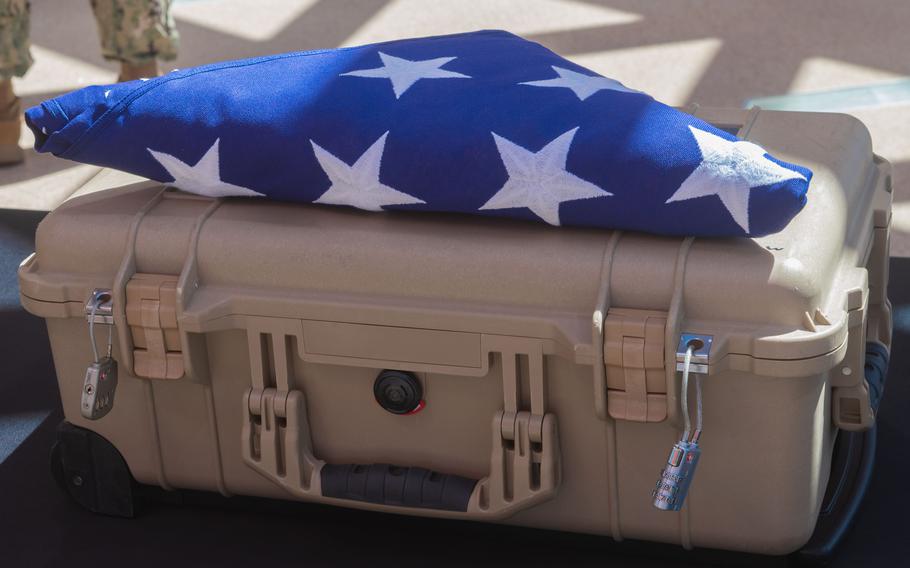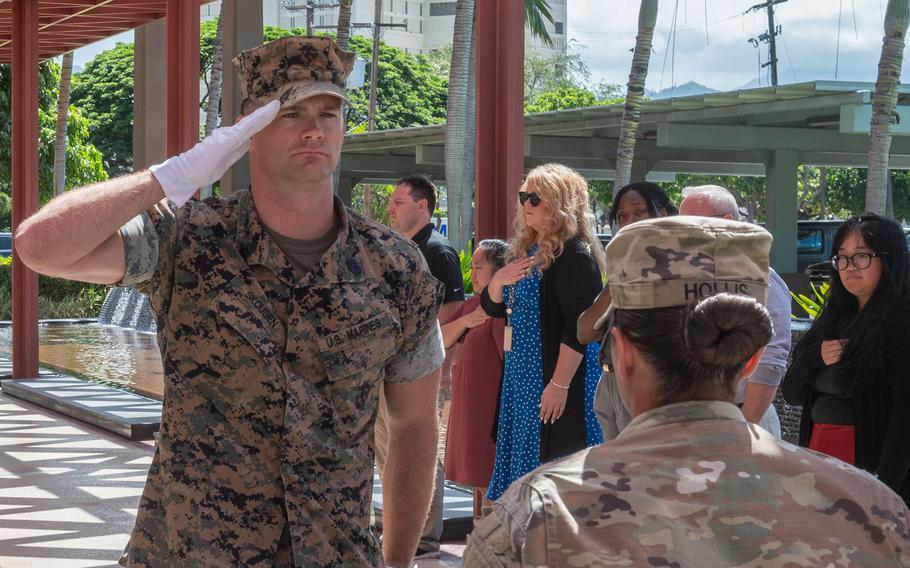
A U.S. flag is placed upon a case containing remains repatriated from Okinawa during an honorable carry ceremony at Joint Base Pearl Harbor-Hickam, Hawaii, July 16, 2025. (Lawrence Whaley III/U.S. Navy)
Japanese scientists using an improved method of analysis recently identified a third set of remains as likely those of an American service member who fought on Okinawa during World War II.
The scientists, using stable isotope analysis on remains discovered in Nishihara town in April 2024, concluded in May that they probably belong to an American, a spokesman with Japan’s Ministry of Health, Labor and Welfare said by phone July 17.
The stable isotope method allows analysts to identify ratios of carbon, nitrogen and oxygen isotopes within body tissues, which can give indicators of where that person may be from, John Byrd, scientific analysis director with the Defense POW/MIA Accounting Agency, said by phone Wednesday.
“Some of them, like the carbon and nitrogen, are heavily influenced by dietary habits, and Americans stand out pretty clearly from Japanese,” he said. “So, we and the labs in Japan, we use this approach to try to determine whether the remains are Americans or Japanese, if it’s from World War II battle casualties. It’s a pretty quick and pretty inexpensive test to run.”
The remains, which analysts believe belong to one individual, were loaned to the DPAA laboratory in Hawaii for further stable isotope and DNA testing in coming months, Byrd said.

Marine Corps Master Sgt. Alexander Skousen renders honors while Army Sgt. 1st Class Sabrina Hollis carries remains from Okinawa during an honorable carry ceremony at Joint Base Pearl Harbor-Hickam, Hawaii, July 16, 2025. (Lawrence Whaley III/U.S. Navy)
A three-member DPAA team collected the remains July 15 from the War Dead Remains Collection Information Center on Okinawa, the ministry spokesman said.
Some Japanese government officials speak to the press only on condition of anonymity.
Only two sets of remains from Okinawa were previously identified as Americans using stable isotope testing since the method was introduced in 2012, the spokesman said.
Because ancient dead were often buried in caves according to Okinawa tradition, scientists must first determine if the remains date from World War II.
“Those caves were used as shelters during the Battle of Okinawa, and some people died inside them,” he said.
The first set of remains, discovered in 2016, were identified as Marine Sgt. Harold M. Weaver, Byrd said. Though Weaver is still listed as unaccounted for on DPAA’s website, the agency’s fiscal 2023 year in review lists him as accounted for.
The second set, discovered in southern Okinawa and recovered by Byrd in May 2024, is still being analyzed by DPAA, he said.
“We have to go backwards,” he said. “Our historians have to figure out who was missing in that vicinity, and then in the laboratory, we do the forensics to then compare what we have to that person.”
More than 100 U.S. service members killed during the battle are still missing “somewhere around the island,” according to Byrd.
The Battle of Okinawa from April to June 1945 killed more than 14,000 American service members, approximately 110,000 Japanese troops and at least 140,000 Okinawan civilians.
More than 187,000 sets of remains have been recovered since the battle, according to the ministry’s website.
DPAA plans to send a team back to southern Okinawa in March and April to investigate the recent discovery sites. The agency may then ask the Japanese government for permission to excavate the sites, Byrd said.
“The only reason we’re having some success getting some remains from Okinawa is because we’ve had great support from the government of Japan and the prefecture government,” he said.